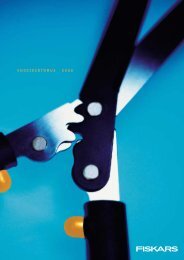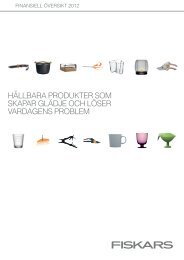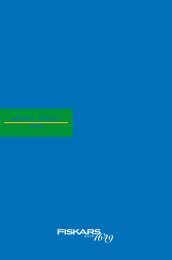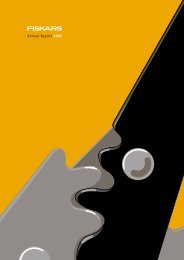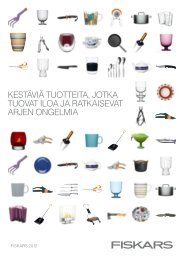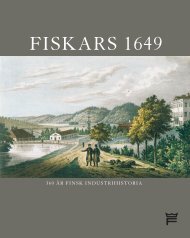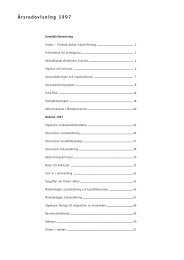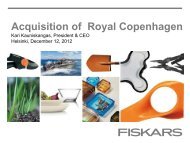FISKARS 1649 â 360 years of Finnish industrial history
FISKARS 1649 â 360 years of Finnish industrial history
FISKARS 1649 â 360 years of Finnish industrial history
You also want an ePaper? Increase the reach of your titles
YUMPU automatically turns print PDFs into web optimized ePapers that Google loves.
Fiskars <strong>1649</strong><br />
The finishing touches to Orijärvi puukko knives were always made by hand.<br />
On the right: Iron-casting in progress at Fiskars’ Åminnefors works. The company’s original business interests, steel production,<br />
were sold in the 1960s to Ovako as part <strong>of</strong> a restructuring.<br />
passed in 1917, and an act on compulsory education<br />
followed in 1921.<br />
The time following the First World War was<br />
a period <strong>of</strong> vigorous expansion and modernization<br />
for Fiskars. Productivity was improved by<br />
developing better steel refining methods and by<br />
renovating the Åminnefors rolling mill. The<br />
product range was expanded, and Finland’s first<br />
metal spring factory was established. The company<br />
bought the Inha ironworks in Ähtäri, a majority<br />
holding in Salon Sähkö- ja Konetehdas Oy,<br />
Billnäs Bruks Ab, Oy Ferraria Ab with its plants in<br />
Jokioinen and Loimaa and in Pero on the Karelian<br />
Isthmus, and Finska Bult- och Spikfabrik Ab. The<br />
1929 stock exchange crash had an impact on the<br />
<strong>Finnish</strong> economy which lasted till the mid-1930s.<br />
The Depression put a stop to Fiskars’ growing<br />
investments. A new upward trend began thereafter,<br />
although this was interrupted by the Second World<br />
War, postponing the planned transformation <strong>of</strong><br />
the small-scale corporate structure into something<br />
better suited to mass production until the postwar<br />
period.<br />
40



